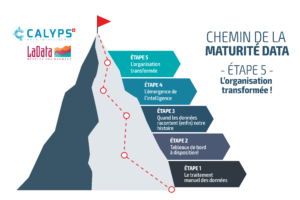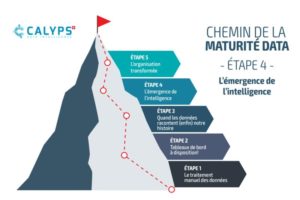Click here to watch the webinar Step 3: When Data Finally Tells Our Story.
As organizations progress in their digital transformation, data begins to tell a story to the teams. The third step of the data maturity path is marked by the expansion of analytical capabilities and the consolidation of data from different sources. To this end, an infrastructure to manage data, as well as good practices for collecting, storing, and organizing it, before drawing the first insights, will have been established.
Data Maturity: Employees at the Heart of Action
This step emphasizes data culture within teams. To fully leverage their data, companies must encourage a data-focused culture and foster collaboration among colleagues. The challenge here is to understand the information each employee really needs to make their work successful. Often, this approach allows operational teams to get closer to their IT service to meet the needs of employees.
By focusing on the role of each employee, it is discovered that to answer their most important questions – for a salesperson: “what are my sales for the month?” for a marketer: “what reach and what cost per contact for this campaign?” for a financier: “what is the billed and collected revenue to date?” etc. – it is necessary to combine and visualize data from multiple internal information systems. To avoid leading to a new overload of information, the data must be aggregated, i.e., reduced to the minimum necessary to answer the questions.
For this, it is important to understand where different roles intersect – e.g., salespeople and their sales manager – ensuring that there are tools to support these interactions. These efforts will have a real impact on data quality and ensure that colleagues who interact have the same information, regardless of the specific tools used in each role.
A Holistic Vision Through Data Consolidation
To obtain insights as precise as required, it is essential to reconcile data from different sources to reach the SPOT, the Single Point of Truth. This may involve the creation of a data warehouse or a data lake by the IT department, these infrastructures allowing to store and integrate data from multiple information systems.
By centralizing data, companies are able to get a holistic view of their operations, their customers, and their performance. This necessarily facilitates strategic decision-making, based on correct and regularly updated information.
Leveraging Predictive Analysis for Enlightened Decisions
Once confident in their use of data, transformed organizations begin to explore emerging technologies such as artificial intelligence (AI) and machine learning (ML) algorithms to anticipate future trends: opening the door to the 4th step of data maturity, the emergence of intelligence.
To summarize: • Data places employees at the heart of action. To better understand each employee’s data needs, data culture must be promoted by management and the IT department. • IT infrastructures such as a data warehouse or a data lake will support the reconciliation of the various data sources used across the organization. • Once the questions of each employee are addressed by a simple screen, giving correct, regularly updated answers and shared within teams, the emergence of intelligence can begin.
Data Maturity Path: Registrations for the June 22, 2023 webinar open
Our next webinar will be dedicated to the 3rd step of data maturity, When Data Finally Tells Our Story. Dreaming of visualizing a dashboard with a data model reconciling multiple data sources? Join us with Laurane Schaerer and Théodmir Donnet, Business Intelligence consultants at Calyps. Click here to watch the webinar Step 3: When Data Finally Tells Our Story.
Click here to access the previous article Step 2: From Spreadsheet to Dashboard.
Click here to access the next article Step 4: From Spreadsheet to Dashboard.





